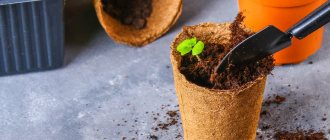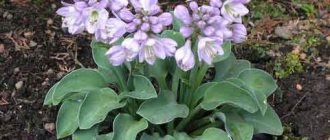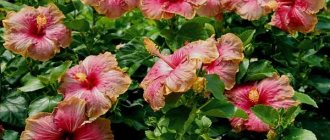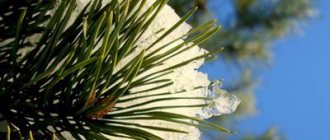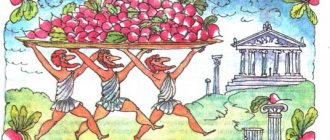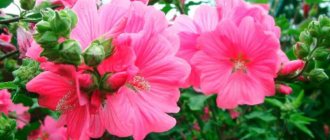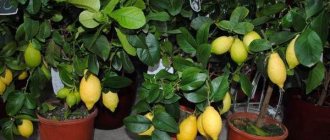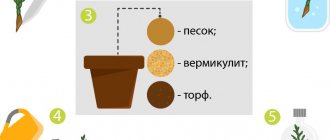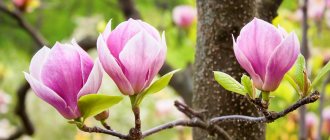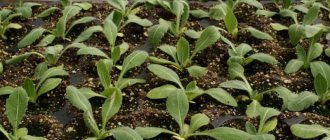Sowing coniferous trees
It doesn’t matter what motivates a gardener who starts planting trees: the inability to find “the same plant” on sale or curiosity. It is important that every self-respecting gardener from time to time buries the seeds of certain trees in the ground, and there are nuances in sowing conifers.
Why sow conifers? Firstly, to obtain a large amount of planting material. Say, for hedges, rootstocks or other purposes. Secondly, many species of conifers are no less good than varietal ones, and some are still difficult to get. Thirdly, to obtain hybrids, plants of a different appearance. You can sow seeds from “witches’ brooms”; there is a possibility that some of the seedlings will have interesting deviations. The volume of crops in this case should be maximum.
For some, “just time” is not enough.
Many conifers germinate reluctantly, and some genera even require “dancing with a tambourine.” Most need at least stratification; it is optimal to sow under snow. An example of slow-growing plants is junipers. Their seeds contain substances that prevent rapid germination, which are washed out with water over time (or are destroyed by special acids). Yes, plus there is a hard peel that the sprout will not immediately break through. Therefore, in order not to wait two to three years for germination, the seeds must be thoroughly washed from peel and resin, rubbed with sandpaper, and then soaked for a long time, often changing the water. The best option is to hang it in a gauze bag in a drain tank, where the water is always fresh. Only after a month can such seeds be sown.
The garden itself will meet us halfway!
If the garden is accessible in winter, then with most coniferous seeds, even those that do not require stratification, it is better to do this. Sow in pots at home, trying to keep the seeds sparsely in the ground, then there is less chance of lightning infections. Sprinkle with a little earth, water, keep for no more than a day in a warm room, and then take it out to the garden and bury it under the snow. It is better to place pots in boxes so that they do not tip over when the snow melts. It’s a good idea to cover the top of the boxes with non-woven material from uninvited guests - birds and mice.
The soil mixture for sowing is not important. There is no need to dig in the pots. In this form, the crops overwinter. In spring, it would be good to move the boxes into the shade so that the crops do not dry out. Complete, fresh, prepared seeds germinate quickly and are not afraid of frost. In the first year of life, they only need to be watered. You can immediately, at the end of May or the beginning of summer, plant the babies in beds or boxes; small seedlings of any breed can easily tolerate this.
Or you can keep it in a pot until next spring. The difference is small.
Many coniferous crops are easy to grow yourself - from seeds
Evergreen trees and shrubs decorate our plots. And they are especially attractive in winter, when there is no other greenery. Instead of the usual leaves, they have needles or scales. And they, like wood, contain a lot of aromatic essential oils. Spiny beauties enrich the air with oxygen and release phytoncides that have a positive effect on health. And the lifespan of many of them is more than 100 years.
— Conifers are the largest and most ancient group of gymnosperms, which most often reproduce by seeds set in cones, —
says
Tatyana Sachivko, head of the botanical garden of the Belarusian State Agricultural Academy. “According to scientists, they appeared long before flowering crops and their ancestors were extinct fern-like crops.
Conifers are grouped into 7 families, 60 genera and more than 560 species. And all this coniferous diversity, it turns out, can be grown by yourself, if only you had the seeds. Cuttings don't always work here. Not only do you need to have an adult mother plant, but also cuttings of some species do not have a very high rooting rate. There are crops that practically do not reproduce vegetatively at all. Seeds are a simple, accessible and cheap way. Especially species plants taken from nature: all parental characteristics are fully preserved. But children of “cultured” parents, Tatyana Vladimirovna emphasizes, can sometimes be unlike anyone else. But it’s even more interesting to observe (and already in the first year) the splitting of needles by color in golden, variegated or blue forms. In the second or third season, differences in the structure of the crown, growth rates will become noticeable (if they exist, of course).
The main mistake that novice “arborists” make is using cones with immature seeds. In larches, fir, spruce, thuja, yew, hemlock they ripen in the fall, and in most junipers and some types of pines - in winter. Therefore, the best period for collecting them is the end of December. It is important that at the time of collection the scales are pressed tightly against one another, and the cone itself remains closed. And it’s better to follow it not into the forest, but into a city park, where crops and varieties adapted to our weather conditions are planted.
Place the collected cones on paper in a warm, dry place, and collect and label the spilled seeds. It must be said that even under room conditions, the seeds of most coniferous crops remain viable for several years in hermetically sealed dark glass bottles, but not in cotton bags. The seeds of fir (white and single-colored) and larches (Siberian and European) are stored worst of all: even freshly collected seeds have a germination rate of just over 50%. Therefore, it is better to sow them immediately, before winter: by spring, germination will decrease by another half.
Freshly collected seeds require additional processing, since they may contain resinous substances (so-called growth inhibitors) that inhibit embryo development and germination. This can be easily done by wiping them with a cloth moistened with ammonia. Yew seeds are surrounded by a juicy, fleshy, red-pink color, which also contains growth inhibitors. Therefore, clean them as quickly as possible.
The seeds of all coniferous crops are in a state of deep dormancy. Its duration depends primarily on the weather that preceded their ripening. Cold and rainy or, conversely, hot and dry summers increase the ripening time of the seed embryo. Therefore, pre-sowing stratification is needed, which will not only speed up seed germination, but also increase their immunity.
Stratification can be carried out in several ways. Firstly, snowmaking. Pour the seeds soaked during the day into canvas bags, place them on compacted snow so that their layer does not exceed 1 cm. Place another layer of snow on top of the seeds and compact them again. And in February - March, cover with spruce branches or sawdust to delay the melting of snow.
It has been experimentally proven that 30-40 days of pre-sowing stratification increases the soil germination of conifers by up to 10% and accelerates the growth of seedlings by 20-140%.
Stratification can be done differently.
After soaking, mix the seeds with wet coarse sand (1:3 by weight), pour into boxes and bury them in the snow for a month or put them in the refrigerator. After that, feel free to sow. The third method is the simplest. Before sowing, soak the seeds for a day in a solution of Epin (1 ampoule per 2 liters of water) or microelements. Then spread them evenly over the surface of the soil, pouring 1 - 2 cm of substrate on top and pouring them thoroughly with the same composition. So the seeds can be sown even in January. Then take the boxes outside under the snow and place them where there is no direct sunlight and is not expected. Otherwise, the substrate itself will dry out very quickly, and young and tender seedlings will get sunburn. Start watering in spring and only as needed. In May, friendly shoots should appear (see table 1).
Table 1
There are other techniques to stimulate seed germination. Grains are sprouted in sand, perlite, sphagnum moss, damp paper towels and even aluminum foil. The last method turned out to be the most effective: the lack of oxygen inside the wrapper speeds up awakening.
Seeds of spruce, fir, larch, pine with small seeds (such as Scots pine), thuja, and cypress germinate well without stratification. But exposure to cold for a month improves their germination. Cedar pine nuts are sown in the fall or stratified for 4 - 6 months. But junipers and yew require two-stage stratification. First, their seeds are mixed with wet sand and kept in a warm (plus 15–20 degrees) ventilated room for 2–4 months. Then 2 - 3 months - in the lower compartment of the refrigerator. This is how summer and winter are simulated artificially.
In some conifers, stratification lasts up to 9–10 months. Their seeds ripen in the second half of autumn, closer to winter. And it turns out: if you sow them freshly harvested, seedlings will appear no earlier than the end of summer, most likely in the fall. Therefore, in order to obtain seedlings of such crops in an acceptable time, their seeds are sown in March - April. Before this, keep in the refrigerator at a temperature no higher than plus 4 - 5 degrees. With this sowing, seedlings will appear at the end of winter or early spring of next year. Actually, the same thing happens in nature: seeds dropped in the fall or at the beginning of winter lie until the next autumn and only germinate in the spring.
Most coniferous crops can hardly be called demanding on the soil. The only soil they don't like is heavy soil. It is very important that it is light and breathable, rich in oxygen. Seedlings should be easily removed from it so as not to injure the roots. It is best to take peat with a fine fraction of sawdust or peat with sand (1:3). It is important that the acidity of the soil is pH 5 - 6. In such a substrate, seedlings of spruce, pine, thuja, larch and other conifers will appear earlier than from garden soil. And the germination rate of seeds is much higher here. Peat is very loose, warms up well, easily absorbs moisture and allows air to pass through. In addition, it is an excellent antiseptic. Not only does it not contain pathogenic fungi and bacteria, but it is also capable of partially disinfecting the seeds that are planted in it. This means that the seedlings will be reliably protected from fungal diseases. Also, for prevention, it would not hurt to etch the seeds for 2 hours in a 0.5% solution of “Potassium Permanganate” before sowing.
The size of seedlings is 2 - 4 times higher when grown in a film greenhouse than in an open nursery. The shelter also reduces the growing time of seedlings by half.
The planting depth should be equal to 4 - 5 times the thickness of the seed.
We sow small grains, such as spruce, fir, larch, Scots pine, to a depth of 0.5 - 1 cm. Level the soil surface (the so-called bed) and lightly compact it with a wooden block. And after sowing, sprinkle the seeds with sand to facilitate the emergence of small and tender sprouts, as well as to prevent the formation of crusts and the growth of mosses. You can sow seeds either in one container (at a distance of 1 cm from each other) or in separate containers. But be sure to proportion their volumes to the size of future seedlings. Too deep containers, as well as very shallow ones, are not suitable for germinating seeds. If the soil layer is small, then the developing roots, resting against the bottom of the container, will begin to diverge in width, intertwining with each other. When picking, their root system will inevitably be damaged and some of the plants will die. Too much soil is also undesirable. The soil, which is not developed by the root system of the seedlings, will become acidic, which will negatively affect the plants.
In order for the seeds to germinate, it is necessary to create comfortable conditions for them. First of all, the temperature regime is plus 22 - 24 degrees. Seeds in pots should be watered approximately once a day. It is important that the soil not only does not dry out, but also does not become waterlogged. Heat combined with excess moisture is a blessing for the proliferation of harmful bacteria and fungi.
Seeds of fir, Douglas fir, hemlock, spruce, larch and double-coniferous pines, with sufficient heat, moisture and air, germinate within 3 - 4 weeks. True, the germination rate of different crops is different (see table 2).
table 2
The first shoots are very fragile and tender. They, like seedlings of garden crops, are threatened by the “black leg” at this time. Therefore, they should be watered exclusively with a spray bottle and only with warm water, the temperature of which should be a couple of degrees higher than the air temperature in the room. It is necessary to protect tender shoots from direct sunlight: they can be destructive for them.
In April, it is already possible to take the seedlings out into the open air. In May - June they are placed in individual cups with a volume of no more than 150 - 200 ml. And after 2 - 2.5 months, the seedlings are transferred to larger pots - 500 ml. But since conifers react painfully to both picking and transplanting, this must be done carefully so as not to damage the mycorrhiza, which is so important for their life.
Mulch the soil in pots well with sawdust or peat. This will protect the young animals from negative environmental influences and increase their defenses. At first, while the root system is growing, the tops will develop very slowly. But then they seem to shoot upward. As soon as 2-3 year old seedlings begin to grow, in the spring they can be planted in a permanent place.
Conifers can also be grown in containers. But it is better to “prescribe” decorative compact and dwarf forms, as well as plants with unusual colored needles, for example, blue or yellow.
(8–017) 311-03-46
If the garden is inaccessible, we will sow at home
The advantages of home sowing are that you control each seedling with a small number of seeds, you quickly respond to any disease, no one will eat the seeds. Disadvantages - germination is worse, infections occur more often, if you need a lot of seedlings, they require a lot of space.
Coniferous seeds are either quite large or very large, so for convenience and to save space, I stratify them in bags or lettuce transparent containers in vermiculite. I pour vermiculite, moisten it quite strongly, add the seeds there, shake it and close it tightly (tie the bag). After a day, I put all this in the refrigerator, where the temperature is 2-3 degrees above zero.
Then I check the seeds regularly. If they begin to sprout, roots 1–3 cm long appear, I take them out of the refrigerator and plant them in orderly rows in pots with steamed soil, which I place in a mini-greenhouse in maximum light. If the window is dark or it is still February - March, the seedlings have to be illuminated, as they need a lot of light for normal development.
How to properly germinate coniferous seeds
Of all the methods I have tried at different times, I consider germination in agroperlite to be the most successful. Indeed, due to its volcanic origin, the risk of developing fungal bacteria that are destructive to seeds is reduced. And also, it absorbs the right amount of moisture and retains it for some time.
Conifer seeds have low germination and require stratification, that is, the creation of a cold and wet period. At home, they are placed in the refrigerator for a certain time. This is especially important if the seeds are not the first year of collection. However, before you begin the process, carefully read the instructions and make sure that this species needs stratification. And the process should begin in the winter months.
1. First of all, the seeds must be soaked in water. It is best to use rain or snow water, but you can also get by with water water, well settled and boiled. For how many days, the manufacturer indicates on the package. The soaking time depends on the density of the shell; for example, grains of Siberian cedar are kept for three days, and real cedar – only 12 hours.
2. Now it’s time to prepare the perlite. It must be soaked in warm water. I pour the required amount of material into a transparent bag, then pour it in and after five minutes I drain the remaining liquid. It’s very convenient to use a colander, and if the holes are large, then I spread an additional layer of gauze.
What will require prompt action?
Fresh seedlings of conifers easily become infected with blackleg. This fungal disease is expressed in the fact that the stem darkens at the soil level and the seedling lies down. At the first sign of disease, it is necessary to remove the diseased ones, and spray the remaining ones with fungicides (for example, “Fundazol”; potassium permanganate is ineffective). For prevention purposes, the soil mixture should be steamed and treated with a solution of the drug “Fitosporin”.
In the first two to three years of life, conifers are generally susceptible to fungal diseases. Young growth must be sprayed prophylactically in spring and autumn with fungicides (HOM, Ordan),
Preparing cuttings for planting in the ground
The next operation is to clear the lower part of the workpiece by about 2 cm from the needles; it is to this depth that the cutting will be buried in the soil substrate. To reduce moisture evaporation, the needles on the upper part can be trimmed a little, but by no means all; the cutting needs photosynthesis, maybe even more than an adult plant.
Very often, cuttings of coniferous plants do not take root, not because they dry out, but because they are affected by diseases, the spores of which are inevitably present on them. Therefore, the next important step is to disinfect the cutting, for which it is immersed in a solution of a fungicide, for example, “Fundazol”. This is not just a short-term dipping, but immersion in the solution for several minutes so that the drug penetrates the internal vessels of the cutting (this drug is systemic).
Then you can stimulate the future formation of roots by keeping the cuttings for the prescribed time in any stimulant: “Kornevin”, “Heteroauxin”, honey, aloe juice, etc.
The next operation is to clear the lower part of the workpiece by about 2 cm from the needles.
The next important step is to disinfect the cuttings.
You can use something loose as a substrate, for example vermiculite.
This is what you will get in return for all your efforts
Seedlings of spruce, pine, fir, and larches will unfold their cotyledons, then release a few more needles and freeze. There is no way to make them fit. Occasionally they give a second small increase in the summer. Junipers, hemlocks, and cypress trees will grow throughout the season. The needles of first-year plants may be completely different from those of adult plants and are called juvenile.
As soon as the newborns get a little stronger, it is better to start opening the greenhouse slightly and accustoming the seedlings to the indoor air. In mid-May, it is quite possible to take them out into the garden, first by placing them in the shade, and then planting them in a garden bed.
Advantages of cuttings of conifers over other methods of purchasing seedlings
When buying ready-made conifer seedlings, we, as a rule, purchase an already viable plant - this is a definite plus of the purchase. The older it is, the more expensive it is – this is a minus. In addition, we may sometimes buy something completely different from what the seller stated and the quality of the seedling may not be the best.
When purchasing, be careful and carefully inspect the plant. The needles should have a rich, bright color characteristic of this variety. The crown must also meet all aesthetic parameters, not be one-sided, curved, and in the case of narrow and columnar forms, not have several tops. Yes, all these defects can be corrected with proper care and proper haircut, but it is best to avoid this at the purchase stage.
Buying seedlings is good, but this is not our method. We want to grow with our own hands. This can be done by collecting and sowing the seeds of a coniferous plant, although many of them will require long-term stratification.
But with this method, you will most likely lose those properties and features that were inherent in this particular variety. To make it clearer: by collecting blue spruce seeds, you will end up with mostly green seedlings, and by collecting the seeds of a beautiful columnar thuja, you will get something shapeless and shaggy.
The third option remains - propagation by cuttings. It is with this method that the resulting seedling will have the entire set of characteristic features of the mother plant - both the shape and color of the needles.
Winter is a great time to take cuttings of coniferous plants. And the gardener has plenty of time during this period, and this is done simply. True, there is a fly in the ointment in this barrel of honey: not all coniferous plants reproduce by cuttings. For example, juniper and thuja are good (thuja is even very good), spruce is worse, but this method of propagation is not suitable for pine. Therefore, before you start, study the plant, read about methods of its propagation.
